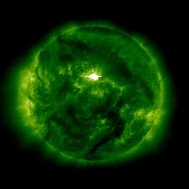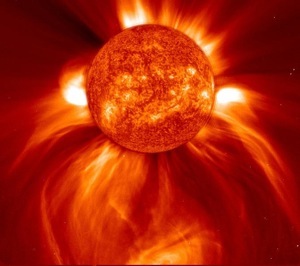
the physics of flares and coronal mass ejections
During these events, large amount of matter (1013 kg) and energy (1025 J) can be released within a few minutes (Figure 2). This provides a natural laboratory to study energy release processes. My previous work provided new insights into these processes via a study of the complexity of the hard X-ray emission. This showed that during a flare, emission from electrons at thermal energies of a few keV exhibited a long term memory, whereas emission from non-thermal electrons (>20keV) exhibited much more short lived spikes. This pointed to a bursty reconnection behaviour in this particular event. It is important to extend this study to a large database of flares and incorporate emission at EUV wavelengths.

With colleagues in Queen’s University Belfast, this is being extended to studies of stellar flares, where X ray emission can be orders of magnitude higher than that of our Sun. In collaboration with colleagues at NASA, this technique will also be applied to the studies of gamma ray burst. Large scale global waves are also evident during a solar flare, as identified one of my PhD students at TCD, and again physically unobservable quantities can be inferred from the wave mode for both solar and stellar data. These are all excellent examples of how Sun-as-a-star projects operate whereby science gained from spatially localised data on our Sun can be extended to all areas of astrophysics.
Coronal mass ejections are large bubbles of plasma ejected from the corona and are commonly, though not always, associated with solar flares. Our studies at TCD have demonstrated that a variable acceleration profile is common as this plasma moves away from the Sun. This breakthrough showed that current theories of CME propagation must be revisited. We have used new data to study the kinematic profile of these events out to the orbit of the earth for the first time. My experience as a STEREO scientist has provided me with the knowledge and collaborations to extend these studies.

The STEREO mission consists of two identical spacecraft in Earth-like orbits, one leading and moving further ahead of the Earth and one lagging and dragging further behind the Earth. With observations from off the Sun- Earth line it is possible to fully reconstruct the 3D corona and study the exact kinematic profiles of these events. The 3D reconstruction involved problems of feature identifications and tracking which will be overcome by collaborating with NASA and ESA. My detailed knowledge of the particle detectors on STEREO will permit these measurements to be combined with in-situ data in the future to study shock formation in the solar system. In comparing the 3D reconstruction to extrapolation from magnetic field data and tracking CME both in-situ and remotely, we will be making major contributions to the science goals of STEREO
